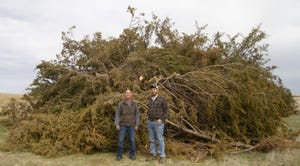Using drought-stressed corn for silage
Iowa State University specialists have helpful suggestions and precautions.

In areas of southern Iowa where drought struck this summer, farmers in mid-August have already started to green-chop their hardest-hit cornfields for forage to feed cattle. Some are harvesting the corn as silage to put in a silo. Green chopping and silage harvesting is also underway in the driest areas of northwest Iowa.
If you are curious as to what the moisture content is of corn plants you’d like to make into silage, here’s a quick test you can do using a microwave oven. The instructions for conducting this test are from Iowa State University beef cattle and dairy specialists.
The ISU specialists can also do a quick test to screen cornstalks for presence of nitrates. Or you can send samples to commercial labs for nitrate analysis. Another option is your veterinarian can send samples to ISU’s veterinary diagnostic lab.
Can you chop droughty soybean crop?
What about harvesting drought-hit soybeans for forage? Soybeans are now in the R3 (begin pod set) to R5 (begin pod fill) stage in southern Iowa.
“We are in that critical window for soybeans, and a decent rain would really help with pod fill,” says Rebecca Vittetoe, Iowa State University Extension agronomist who covers south-central and southeast Iowa. “Some farmers are thinking of harvesting soybeans for forage. Talk to your crop insurance provider first. Also, double-check the labels of the pesticides you’ve applied this year to make sure it’s legal to harvest the soybean plants as forage.”
If corn plants are stressed in the field, there will likely be challenges ensiling that corn and feeding the silage, she adds. For information on nitrate toxicity in drought-damaged corn silage, see the fact sheet “Nitrate Toxicity” on the Iowa Beef Center website. Additional drought-related information is available at ISU’s Dealing With Drought website and the Iowa Beef Center website.
Beware of nitrate accumulation in corn
“Nitrates can accumulate in corn plants when corn is under drought stress, and high levels of nitrates can be harmful to animal health,” says Renato Schmidt, forage specialist with Lallemand Animal Nutrition. “You can still produce good silage from drought-stressed corn as long as the crop is harvested correctly, ensiled well and carefully stored.”
Don’t take high-nitrate corn lightly, he warns. Even subclinical nitrate toxicity can result in decreased cattle intake, weight gains and production, and conception rates, as well as embryonic death and, occasionally, abortions.
Nitrates accumulate in the bottom third of the plant. Thus, you should cut drought-stressed corn silage crops higher on the stalk than you would for a normal corn silage crop. Assess the degree of drought stress in the field, advises Schmidt. Then make your decision of when to harvest based on the guideline of the corn reaching half to two-thirds milk line in the corn kernel. Also, you can base your decision on a whole plant dry matter (DM) of 32% to 38% if ear and kernel development appear normal — at least 80% of normal bushel yields. “If yield is severely reduced, then harvest the corn for silage based solely on the whole plant DM target value,” he says.
Should you add a silage inoculant?
Drought-stressed corn tends to have low levels of lactic acid bacteria, which are essential to drive the initial silage fermentation process. Droughty corn also tends to have higher levels of yeasts and molds, and so, has more issues. Using a proven combination silage inoculant can help address both of these challenges, says Schmidt.
The ensiling process itself can reduce nitrates by 50% to 70%. However, it’s important to give ensiling time to work. “Never feed freshly chopped forage coming from a drought-stressed field,” he says. “It’s important to let the forage ensile for at least three to four weeks. Then, introduce it gradually into the ration.”
Test nitrate in corn plants before feeding
Testing nitrate levels of silage or green-chopped corn prior to feeding helps avoid toxicity problems when feeding droughty corn silage or green-chopped corn to cattle, says Schmidt. The droughty silage can be mixed with other silage or forage at varying amounts depending on nitrate test results, but if the corn plants have levels of 1.5% nitrate or greater, the silage should not be fed.
“Most importantly when harvesting drought-stressed forage, consider your own safety. Be cautious when unloading silage made from corn with high nitrate levels,” Schmidt warns farmers. “Nitrogen oxide gasses produced early during ensiling are lethal to both animals and humans.”
These gasses are typically only a concern during the first few days of ensiling and tend to accumulate in low areas as they are heavier than air, he says. The gas can be colorless or look reddish-brown. To dissipate the gases, Schmidt says to run the blower for 15 to 20 minutes before entering an upright silo and use caution around vents in silo bags. Workers should wear a respirator, especially when entering an upright silo to guard against these gases and prevent asphyxiation due to carbon dioxide, the most common silage gas.
About the Author(s)
You May Also Like
.png?width=300&auto=webp&quality=80&disable=upscale)


